The waxy cap family is huge and complicated, and it is still being explored and cataloged. While several North American waxy cap mushrooms are relatively easy to identify, they’re generally a tough group to nail down on an individual level. Even the most experienced mycophiles often just say “waxy cap” and leave it at that!
These are often very beautiful, brightly colored mushrooms. They catch the eye and call out to the forager!
But, even though they’re hard to tell apart from each other, they’re quite easy to differentiate from other mushroom families as a whole. Most waxy caps have clear telltale signs that put them in the waxy cap family. At least there’s that! Waxy caps are generally not edible, but they’re not toxic either. Their flesh is generally not palatable, and their bodies are usually so small that they’re not worth the effort.
Waxy caps show up in identification requests all the time because the bright red and yellow ones look passingly like chanterelles to the new forager. Telling them apart is pretty easy, though, once you learn the main characteristics.
- Scientific Name: Hygrocybe, Hygrophorus
- Common Names: Waxy caps, Waxcaps
- Habitat: on the ground
- Edibility: Not edible
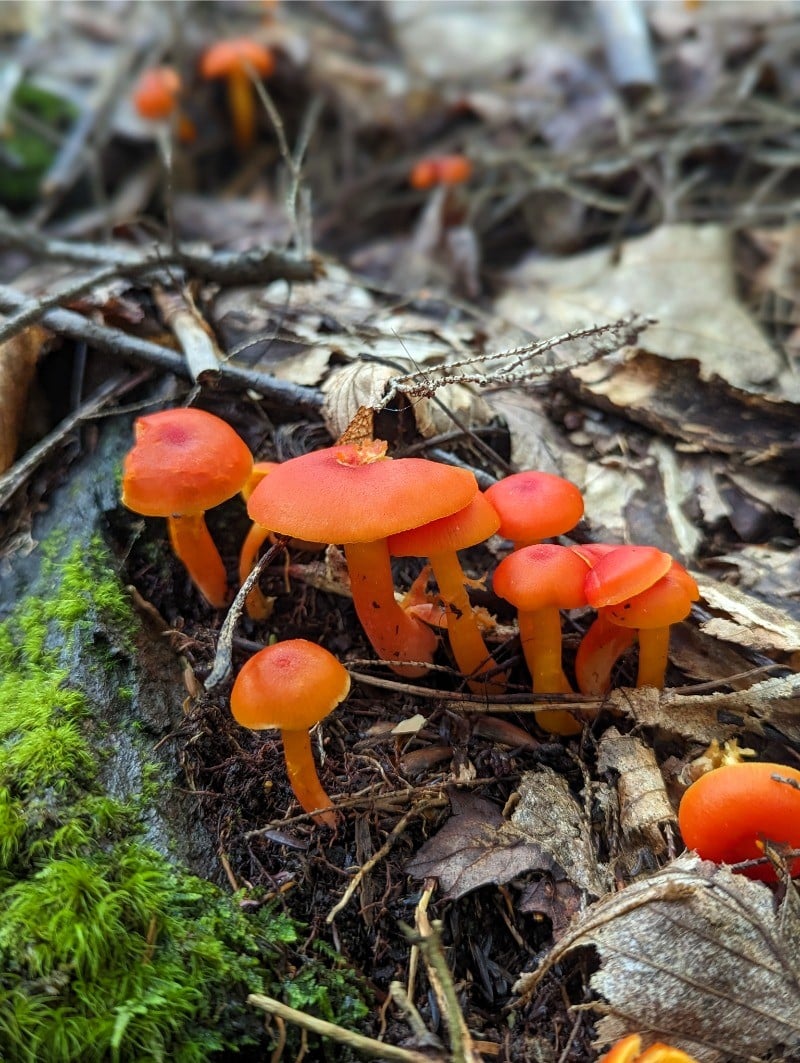
Jump to:
All About Waxy Cap Mushrooms
Waxy cap mushrooms are characterized by their smooth, slippery-looking, often brightly colored caps. They often show off with vibrant red, orange, yellow, and even blue or green hues. Beneath the caps, the gills are typically thick, waxy, and distant, sometimes contrasting starkly with the cap color.
There are hundreds of species of waxy caps in North America. Mycoportal reports 224 here, although that is definitely not final and will change when more research is done. This count includes species from the genus Hygrocybe, Hygrophorus, and Cuphophyllus, among others. All of these genera fall under the broader Hygrophoraceae waxy cap family, which contains over 1000 species. In this guide, we’re only going to cover a very small fraction of these species, focusing on the ones that are most distinguishable to the average forager.
The genus name Hygrocybe is derived from the Greek words “hygros” meaning “moist” and “kybē” meaning “head.” It was first formally described by Swedish mycologist Elias Magnus Fries in 1821. The family was initially classified as a subsection of the genus Agaricus but later elevated to its own distinct genus in 1871 by German mycologist Paul Kummer.
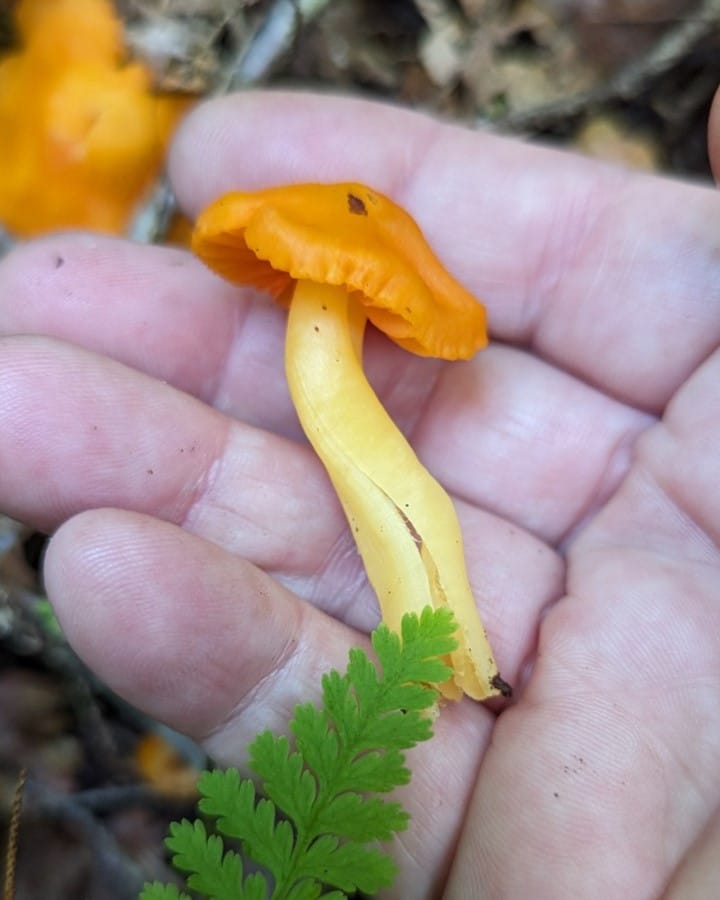
Waxy Cap Mushroom Identification
This is a general guide to the common attributes of waxy cap mushrooms. There are at least 200 species in North America. This abundance of species is just one part of the reason these fungi are so complicated to identify species-wise and why they are so frequently encountered in the woods.
There are two main types of waxy cap mushrooms –
- Large, rounded, and light-colored – these have medium to large rounded caps and are dull brown to yellow to gray and sometimes pink.
- Small and brightly colored – these have small cone-shaped or rounded thin fleshed caps and are bright red, orange, bright yellow, and green.
These are the key features you need to pay attention to if you want to attempt waxy cup mushroom identification. This is in addition to cap, stem, and gill coloring, habitat, and size. Remember to always start with a fresh specimen. Dried out or old mushrooms won’t look the same.
- Is the cap shiny or sticky or not?
- Is the stem shiny or sticky or not?
- Do the gills run down the stem, or are they attached to the top of the stem?
- What does it smell like?
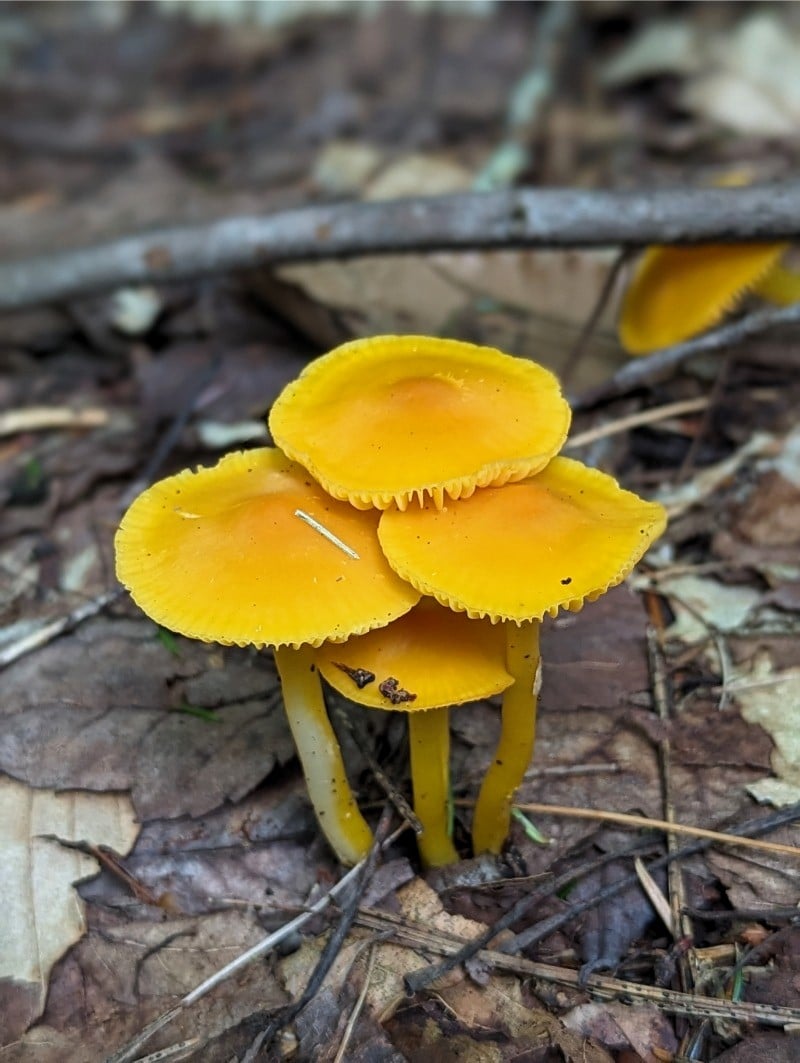
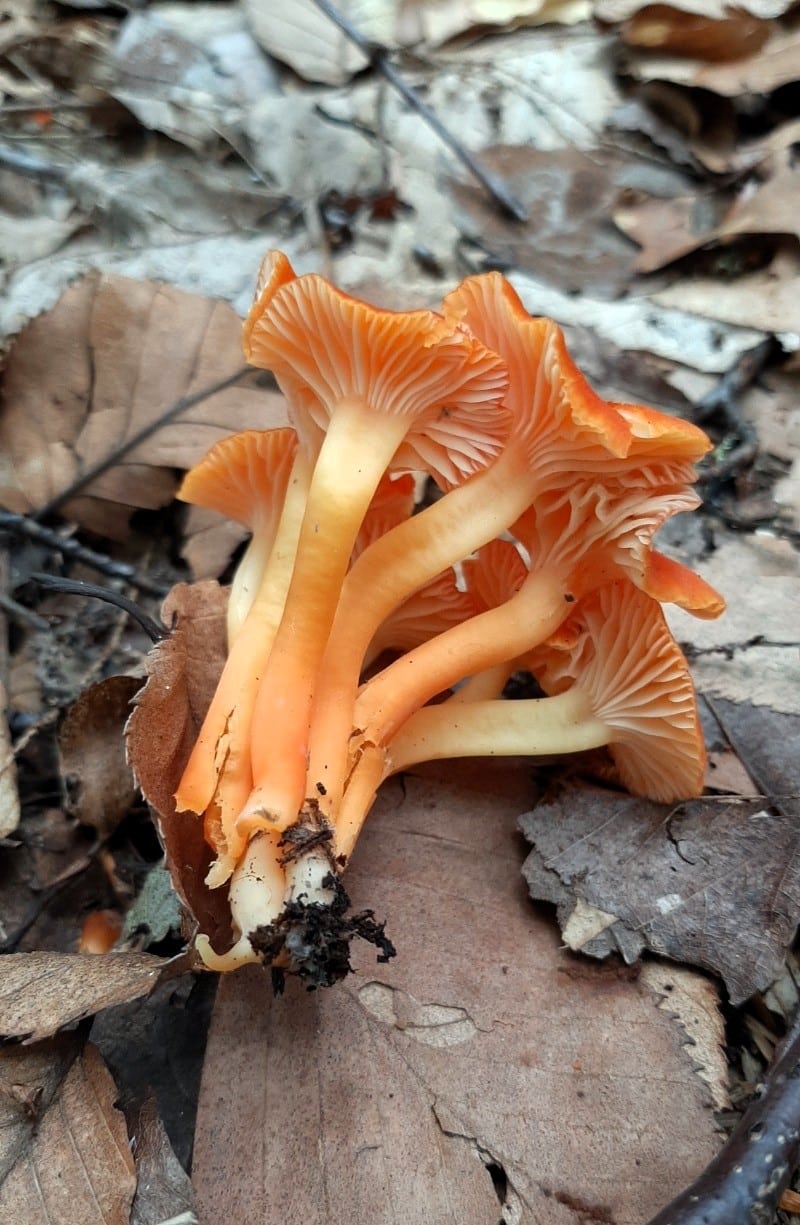
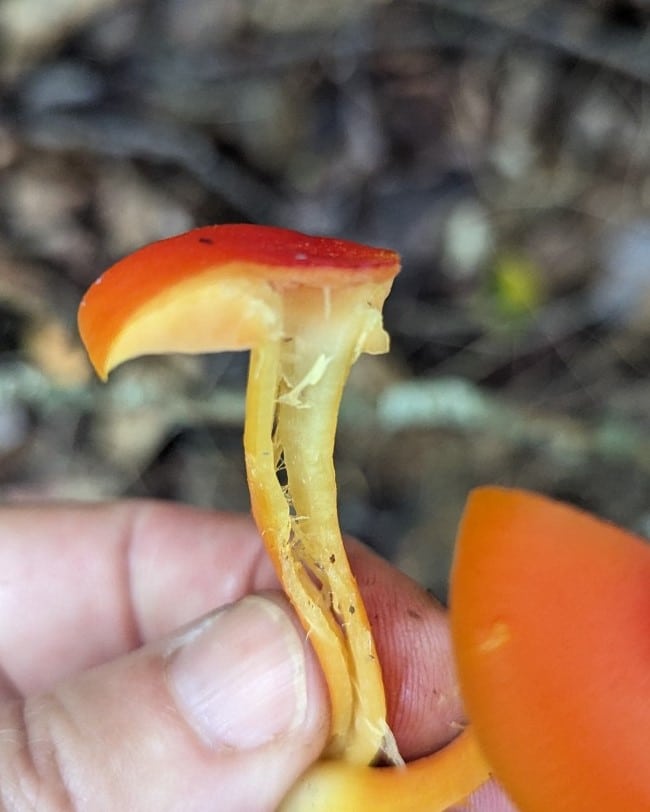
Key Waxy Cap Mushroom Features
- Has a rounded or cone-shaped cap
- Cap is slimy or sticky or looks like it is weeping
- Has gills
- Gills are thick and widely spaced
- The stem is thin and fibrous or hollow
- The stem does not have a ring around it
- Waxy flesh, looks shiny
Season
Waxy cap mushrooms can be found throughout the year, with some species appearing in spring and others more commonly encountered in late summer or fall.
Habitat
Hygrocybe species are predominantly soil-dwelling, with a strong association with specific habitats. They appear in forests and fields around the globe. The mushrooms appear singularly, in scattered groups, or sometimes in clusters.
Recent research suggests that they are not purely saprotrophic (decomposers) but rather form symbiotic associations with the roots of higher plants or mosses. This biotrophic lifestyle, where the fungi derive nutrients from living host organisms, is a crucial aspect of their ecology.
Spore Print
The spore print of all waxy caps is white.
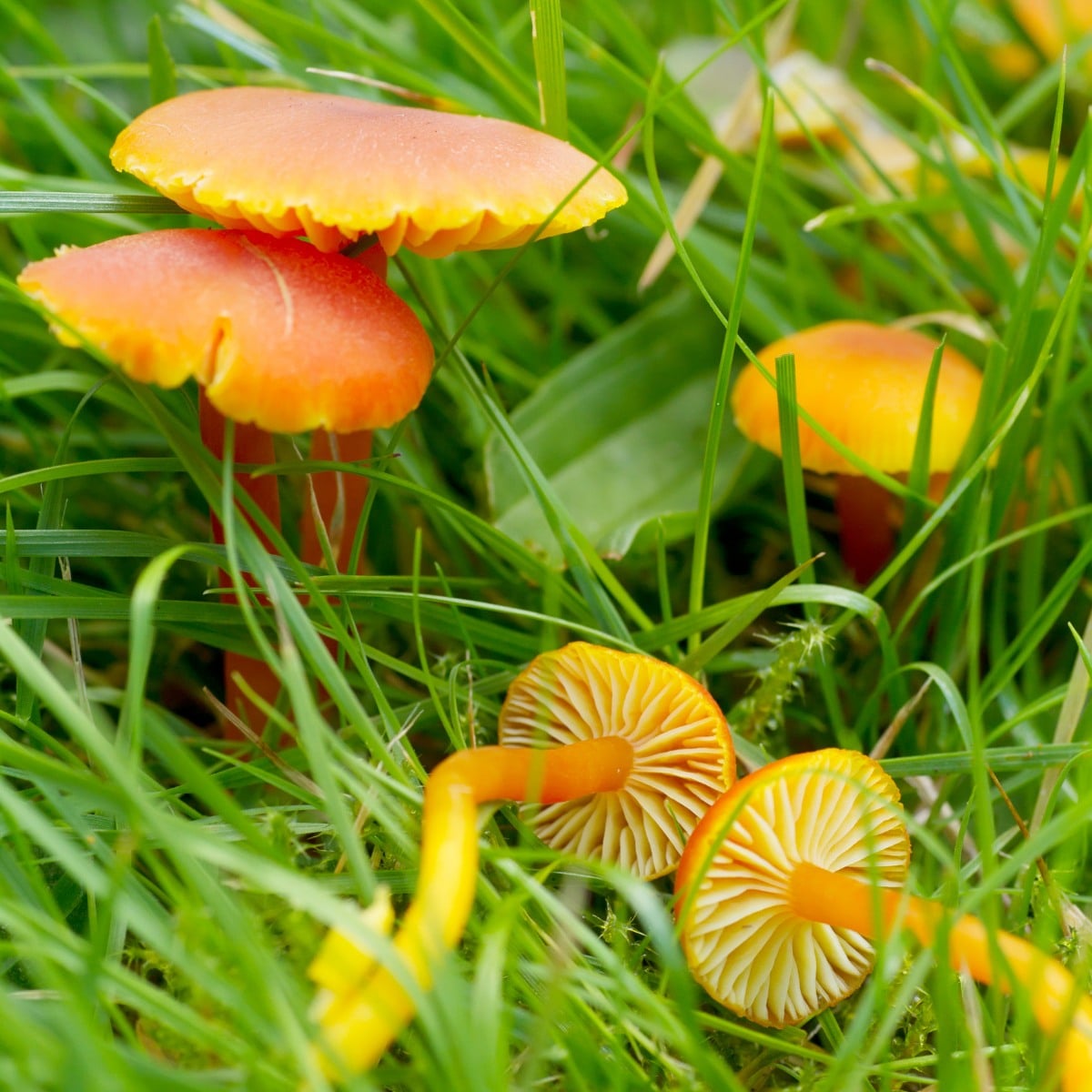
Waxy Cap Mushroom Lookalikes
Chanterelles (Cantharellus)
Golden chanterelles are, as their name suggests, golden yellow. Often they look like egg yolks on the forest floor. The bright yellow waxy cap mushrooms can easily be confused with chanterelles from the top — more than one forager has gone bounding into the woods after that bright yellow cap only to discover it is not actually the treasured chanterelle.
The similarities end with the bright color, and once you get close, it’s generally pretty easy to see you’ve found a waxy cap. Waxy caps have true gills, not folded or melted on looking false gills like the chanterelle. Also, chanterelles are dense with white or light yellow flesh. Waxy caps are thin, often have a hollow stem, and are generally unsubstantial and fragile.
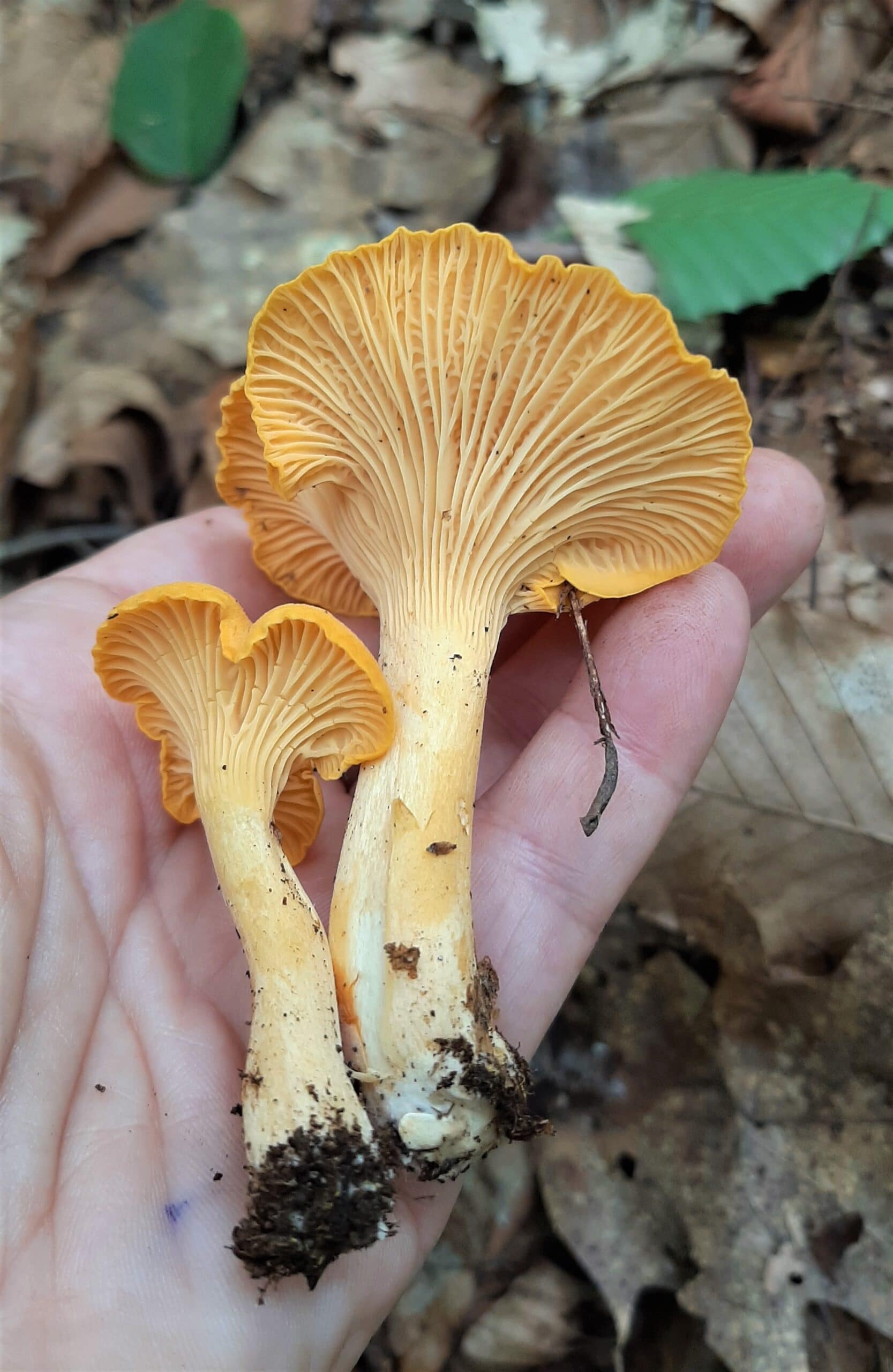
Waxy Cap Edibility
A few Hygrocybe species are considered edible and are sometimes collected and consumed locally in various regions. However, it is essential to exercise caution, as the edibility of many waxy cap mushrooms remains uncertain, and some species may be poisonous. Proper identification by an expert is always recommended before consuming any wild mushrooms.
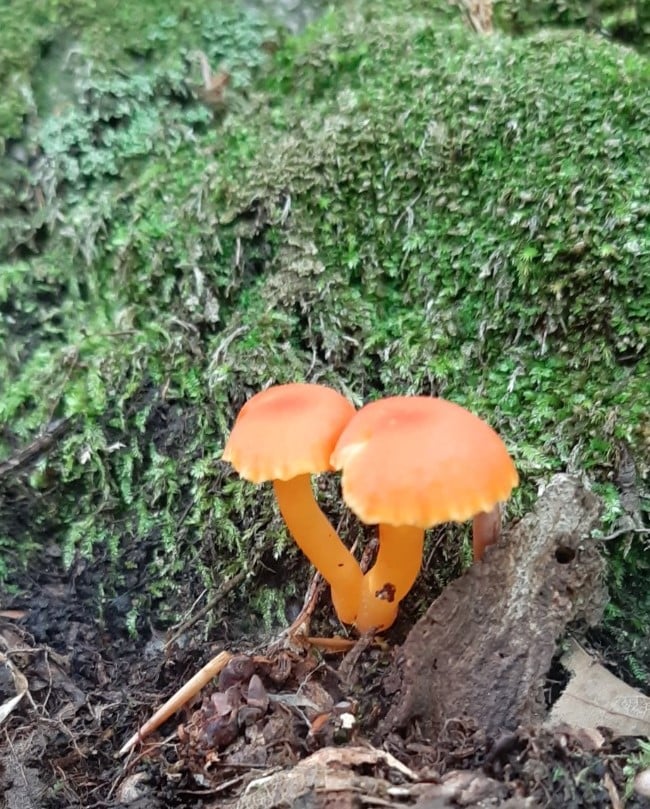
Notable Waxy Cap Species in North America
Blackening Waxcap or Witch’s Hat (Hygrocybe conica)
This striking waxy cap mushroom has a brightly colored orange, yellow, or scarlet color. The stem is yellow to orange, and the gills are pale yellow or white. As the mushroom ages, all parts of the waxy cap dull and turn gray until finally turning completely black. The mushroom will also stain black when handled or bruised. It appears in summer and fall, mainly in conifer forests and around oaks.
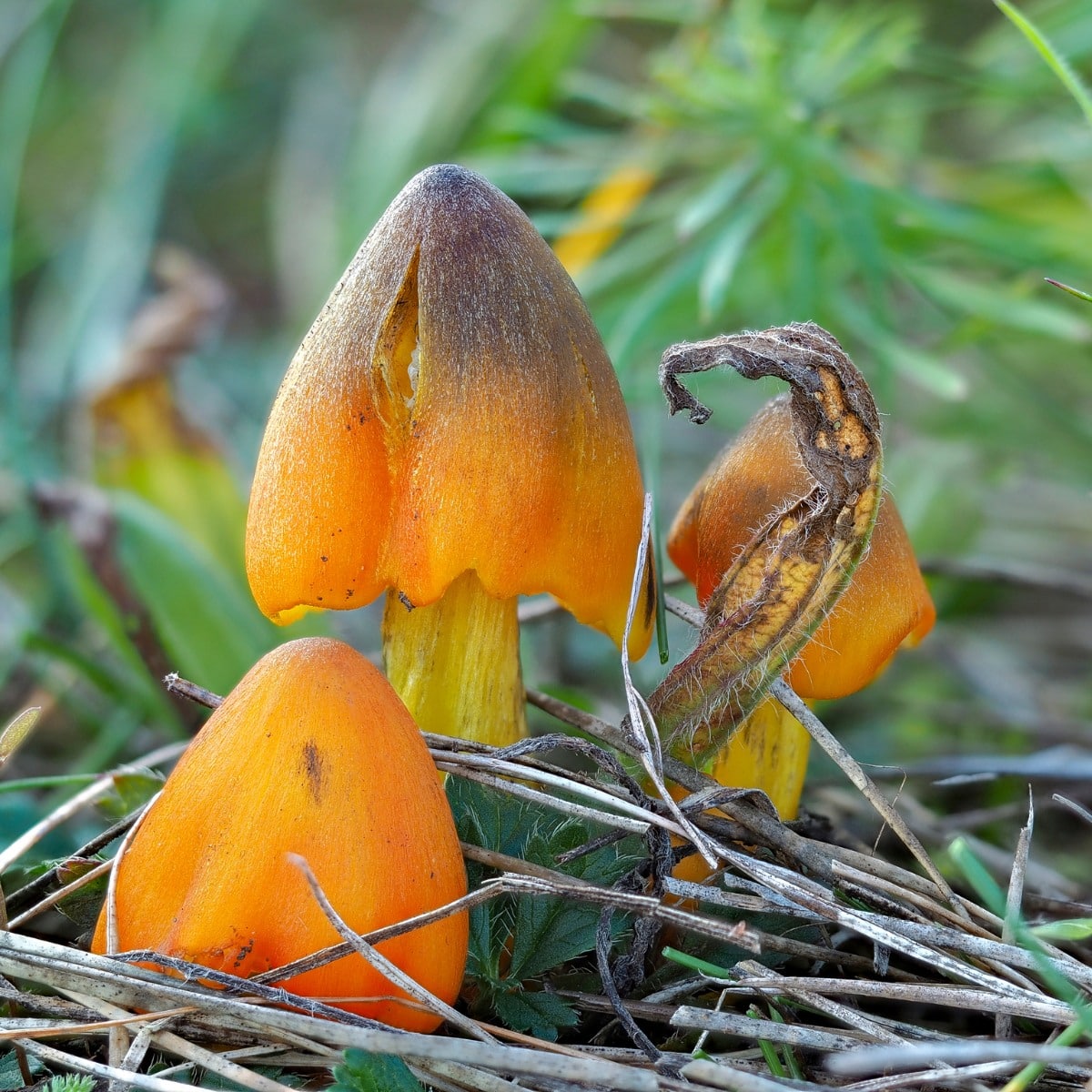
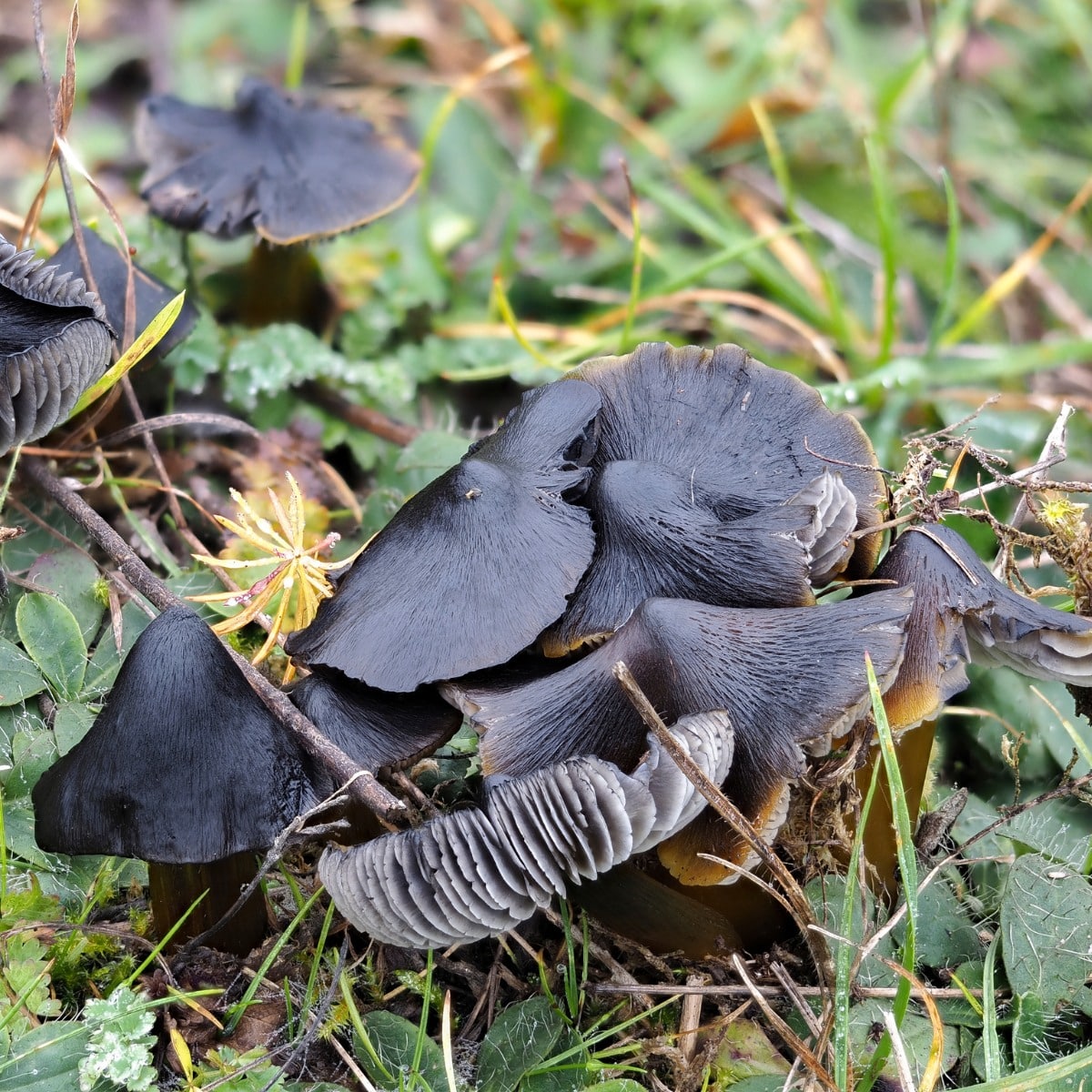
Chanterelle Waxy Cap (Hygrocybe cantharellus)
This species is most commonly confused with cinnabar chanterelles. The common name does nothing to help the confusion, either! Chanterelle waxy caps have a reddish-orange cap and stem, and their gills are yellowish. The gills are widely spaced and run slightly down the stem. This species fruits prolifically east of the Great Plains under hardwoods.
To differentiate it from the cinnabar chanterelle (which is a top edible species), compare the gill color and the flesh color. Cinnabars have red false gills and white flesh. They also smell sweet while the waxy cap does not have a distinctive scent.
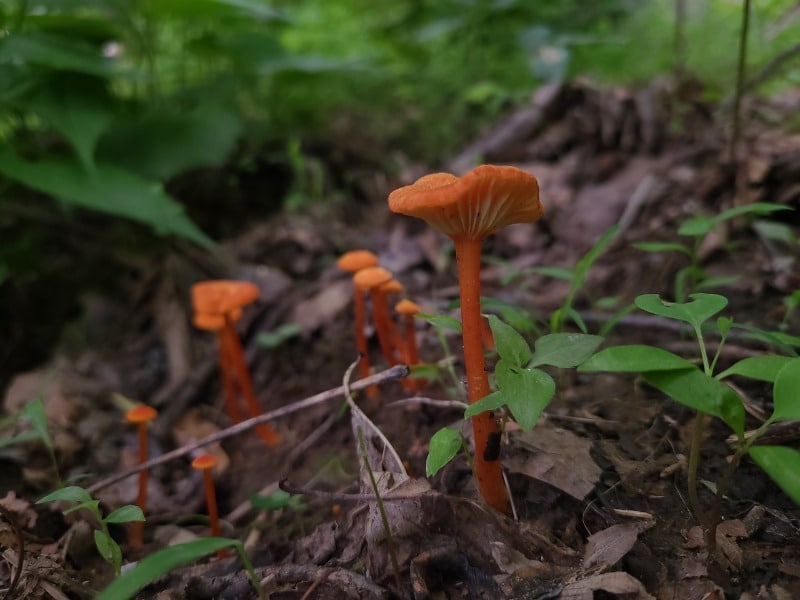
Golden Waxcap (Hygrocybe chlorophana/Hygrocybe flavescens group)
The vibrant lemon to orange yellow cap of this species really makes it stand out. The gills are also yellow but paler than the cap, and the stem is the same as the cap. It is found in coniferous and mixed forests.
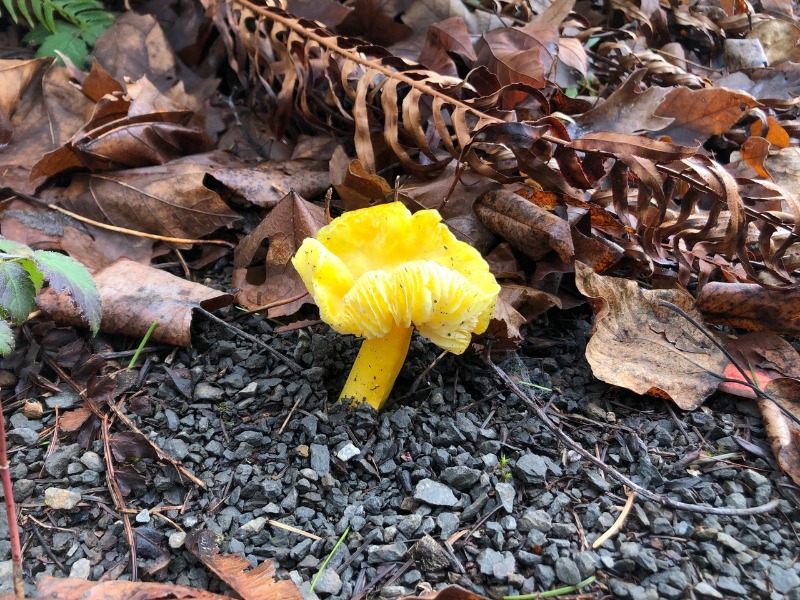
Appalachian Waxy Cap (Hygrocybe appalachianensis)
This is a red-capped species known from the wider Appalachian region, from Ohio south to South Carolina. The coloring of these waxy caps is very distinctive—deep purplish red to reddish-orange, though it does fade with age. The stem is similar to the cap, usually fading a bit closer to the base. Gills on this species are thick, widely spaced, and either the same color as the cap or a bit paler.
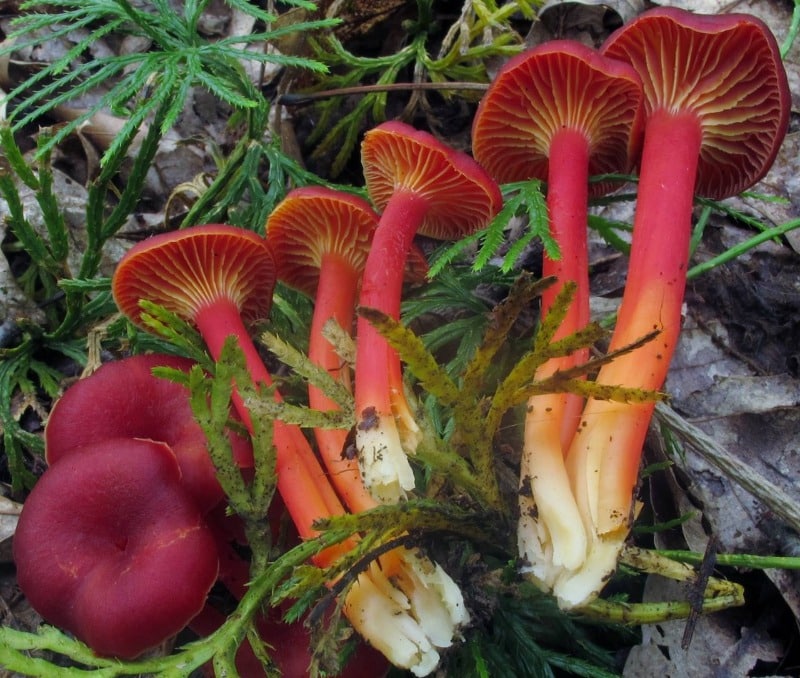
Scarlet Waxcap (Hygrocybe coccinea)
These waxy caps are brilliantly red through and through. The cap is scarlet red, the gills are reddish, and the stem is scarlet red. It is a small mushroom, but it really catches the eye. This waxy cap is only found in the Pacific Northwest and Europe. In the PNW, it appears in winter around redwoods. It is said to be edible but not that interesting.
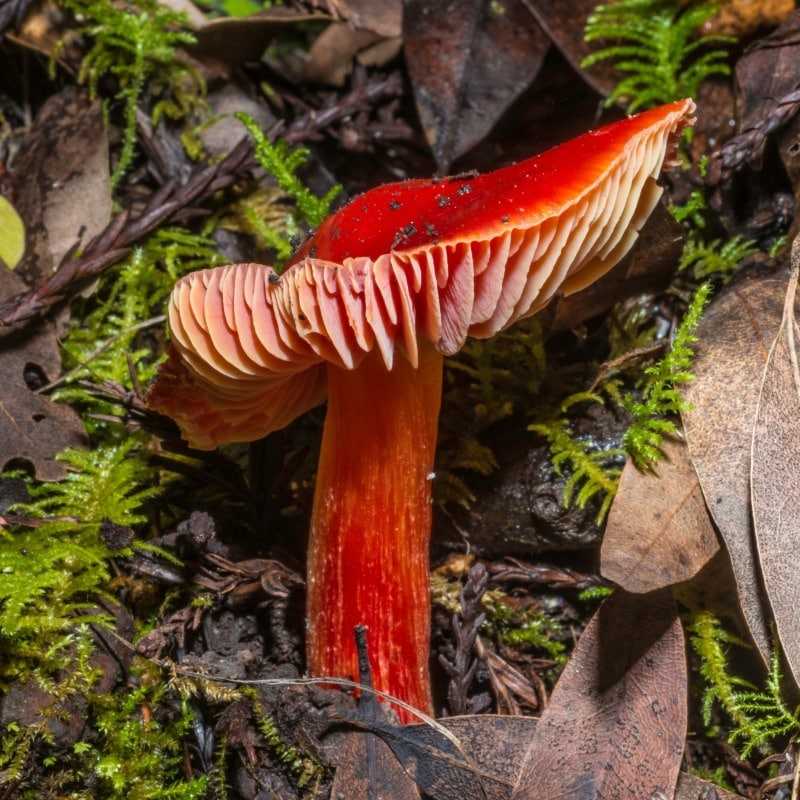
Larch Waxy Cap (Hygrophorus speciosus)
The cap of this species is a brilliant orange-red and sticky. It has yellowish gills and a white stem that stains orangish as it matures. This waxy cap is widespread in North America and grows with conifers, especially larches and ponderosa pines.
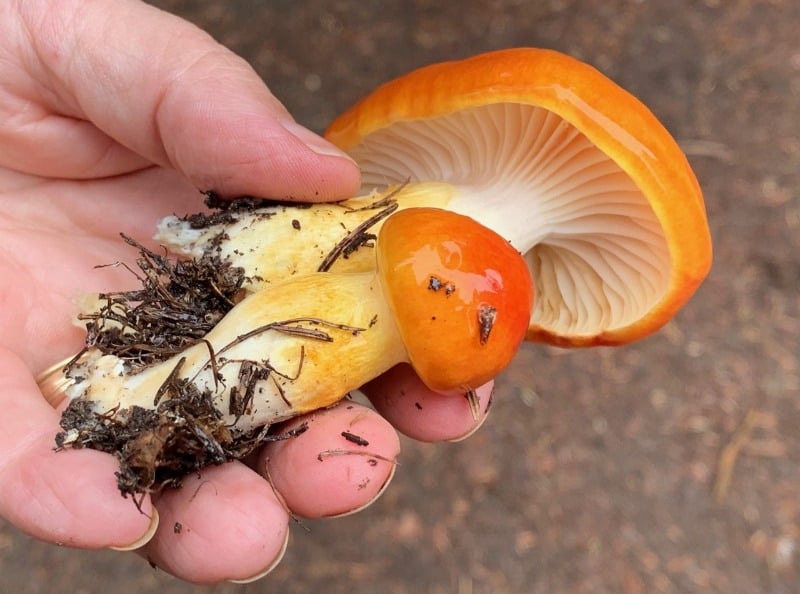
Parrot Mushroom (Gliophorus psittacinus)
The aptly named parrot mushroom has young caps that are green or blue and mature to shades of red, orange, or yellow. It is easy to distinguish when it is young with its bright green coloring. As it matures, though, it darkens and fades until it is a dirty yellowish color and rather unremarkable.
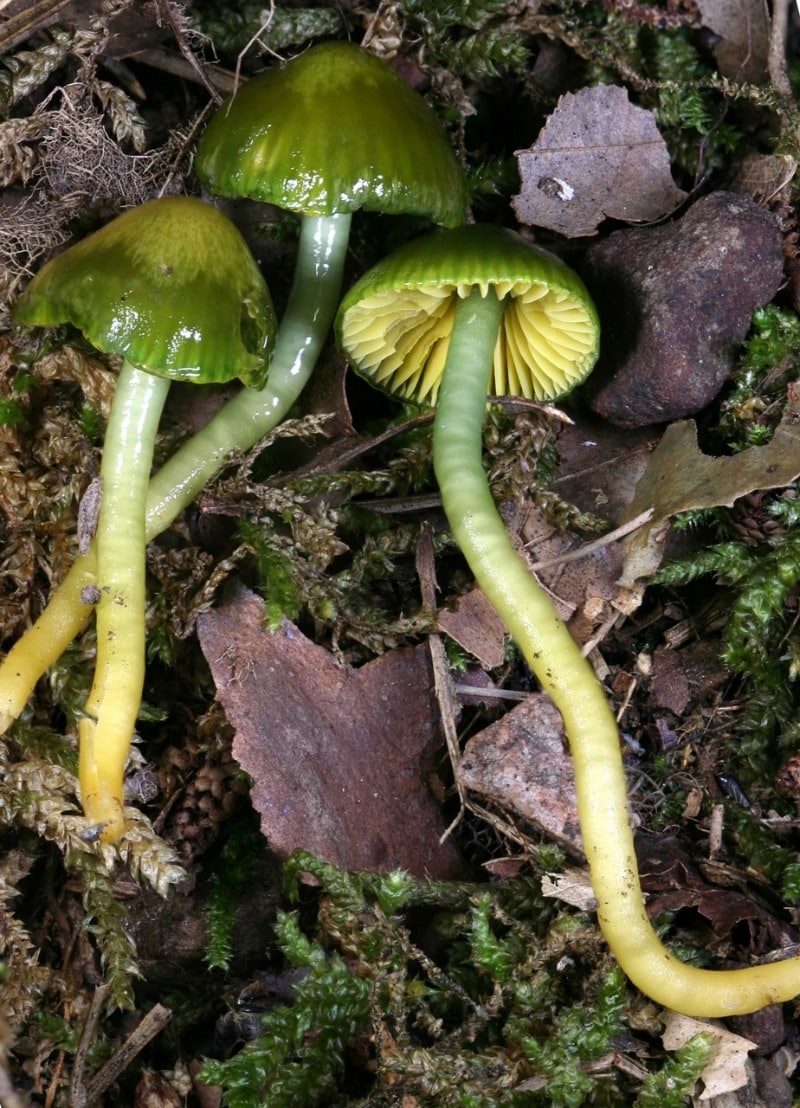
Waxy Cap Conservation Concerns Around The World
The decline of unimproved grasslands, a preferred habitat for many Hygrocybe species, has led to the inclusion of several European waxy cap mushrooms on the IUCN Red List of Threatened Species. Species such as Hygrocybe citrinovirens, H. punicea, H. spadicea, and H. splendidissima are now considered globally “vulnerable.” Outside of Europe, other rare and localized endemic Hygrocybe species, like Hygrocybe boothii in Australia and Hygrocybe noelokelani in Hawaii, have also been assessed as “endangered.”
These conservation concerns highlight the importance of preserving the delicate ecosystems that support these captivating fungi, as well as the need for further research and monitoring to ensure the long-term survival of Hygrocybe species worldwide.
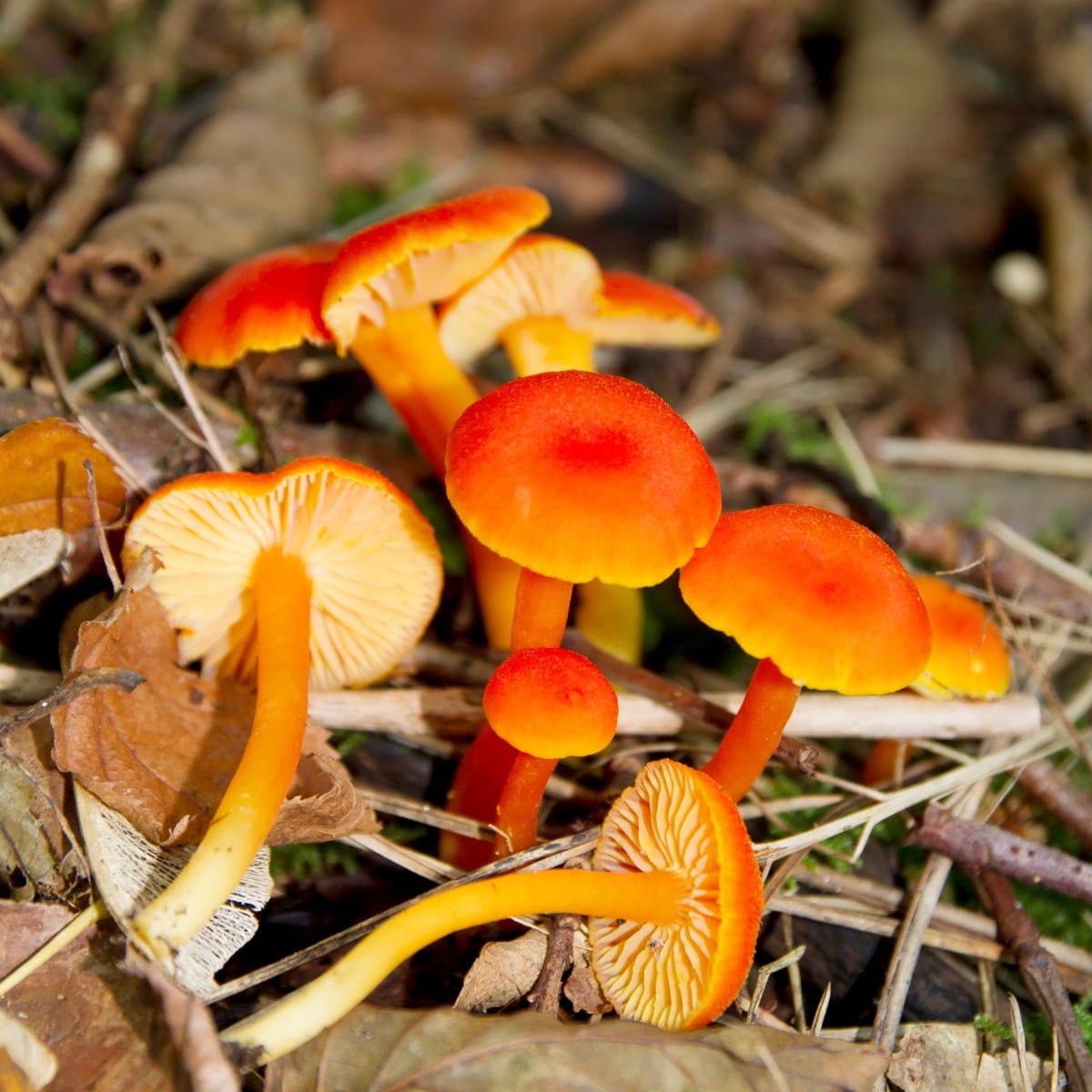
Common Questions About Waxy Cap Mushrooms
Can you cultivate waxy cap mushrooms?
No. Their likely symbiotic relationship with trees and plants is too tricky to replicate. Also, not many people have tried because this is not a top edible mushroom species.





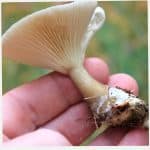

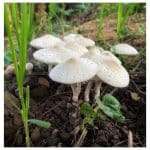
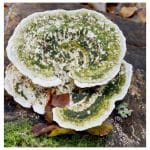
Leave a Reply